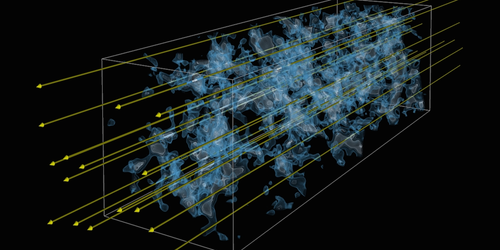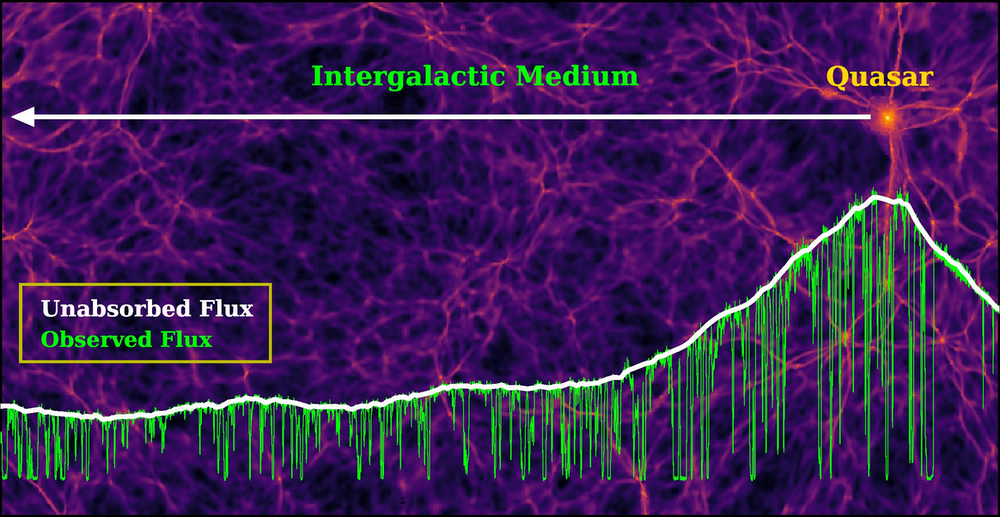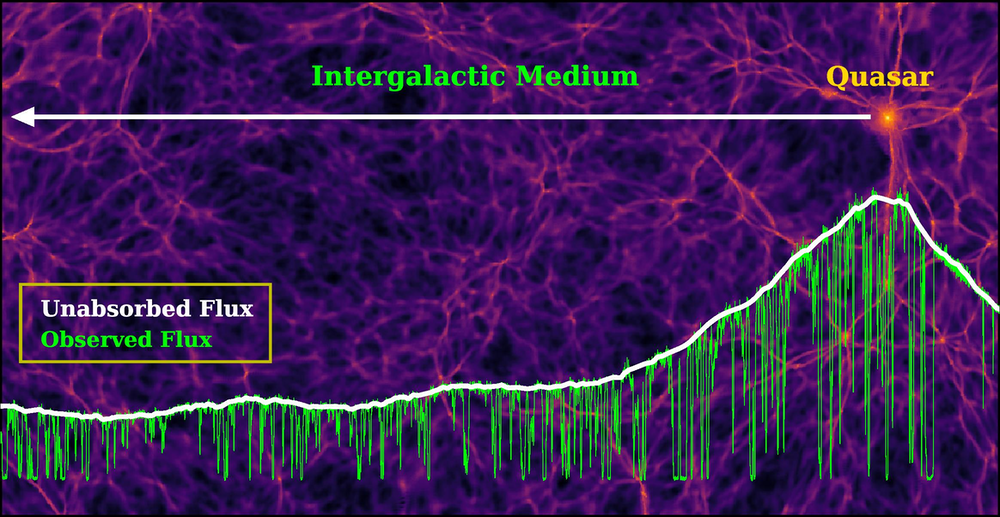Dark Matter as an Intergalactic Heat Source
Dense gas clouds across the Universe absorb light from distant quasars, producing absorption lines in the quasar spectra. A new study shows that the larger-than-predicted widths of these lines from nearby gas clouds could result from a form of dark matter called dark photons [1]. These particles could heat the clouds, leading to a widening of the absorption lines. Other explanations of the broadening—based on more conventional heating sources—have been proposed, but if the dark-photon mechanism is at work, it might also cause heating in low-density clouds from earlier epochs of the Universe. Researchers are already planning to test this prediction.
When viewing the spectrum of a distant quasar, astronomers often observe absorption lines coming from the intervening clouds of gas. The most prominent absorption line is the Lyman-alpha line of hydrogen. Indeed, some quasar spectra have a “forest” of Lyman-alpha lines, with each coming from a cloud at a different distance from our Galaxy (or different epochs). By examining the widths, depths, and other details of the line shapes, researchers can extract information about the density, the temperature, and other features of the clouds. This information can be compared with the results of cosmological simulations that try to reproduce the clumping of matter into galaxies and other large-scale structures.
Comparisons between forest data and simulations have generally shown good agreement, but a discrepancy appears for relatively nearby gas clouds. Observations show that these so-called low redshift clouds produce broader absorption lines than predicted in simulations. “This may be an indication of a particular candidate of dark matter, which is called a dark photon,” says Andrea Caputo from CERN in Switzerland. “This dark photon can inject some energy and heat up the gas, [which makes] the lines a bit broader, in better agreement with the data.”
To explore how this energy injection might work, Caputo and his colleagues ran cosmic simulations with dark photons. The theory of dark photons assumes that the particles can spontaneously turn into normal photons with some small probability, but this conversion can be enhanced when dark photons enter an ionized gas satisfying a resonance condition. The condition amounts to the gas having a certain density, which is determined by the dark photon’s mass. If an intergalactic cloud has this density, then the ordinary photons generated by the resonance conversion will heat the gas.
Caputo stresses that a cloud’s density changes over time, so the resonance condition will be met for only a certain period of time. This time-dependent heating is unique to dark photons, as other proposed types of heat-producing dark matter, such as those that decay or annihilate, are expected to be “switched on” all the time. However, models of continuous heating are constrained by other cosmological observations, such as the cosmic microwave background, which don’t show signs of unexplained heating.
The simulations of Caputo and colleagues suggest that dark photons with an extremely small mass of around 10−14 eV/c2 (roughly 1019 times smaller than the electron mass) would resonantly convert to photons in low-redshift Lyman-alpha clouds. This conversion would inject between 5 and 7 eV of energy per hydrogen atom into the gas, enough to account for the observations.
In addition, the team predicts that dark-photon heating might have occurred at higher redshift, but only in so-called under-dense clouds, which in the past had higher densities—potentially high enough to meet the resonance condition. The team is currently running simulations to see if this predicted heating would agree with observations of high-redshift clouds.
However, exotic dark matter physics models may not be required to explain the Lyman-alpha data, says astrophysicist Blakesley Burkhart from Rutgers University in New Jersey. She says dark photons are an exciting possibility, but researchers have not yet ruled out more conventional heating sources, such as supermassive black hole jets at the centers of galaxies, known as active galactic nuclei.
Sam Witte—a cosmologist from the University of Amsterdam—agrees that the dark photon explanation is more speculative than other scenarios, but he thinks the researchers have made a convincing case with testable predictions. “Should future studies exclude conventional astrophysical explanations, it is compelling to consider the possibility that we might be observing the first nongravitational imprint of dark matter,” he says.
–Michael Schirber
Michael Schirber is a Corresponding Editor for Physics Magazine based in Lyon, France.
References
- J. S. Bolton et al., “Comparison of low-redshift Lyman-𝛼 forest observations to hydrodynamical simulations with dark photon dark matter,” Phys. Rev. Lett. 129, 211102 (2022).






